July 31, 2025
Prelims Pointers
July 31, 2025
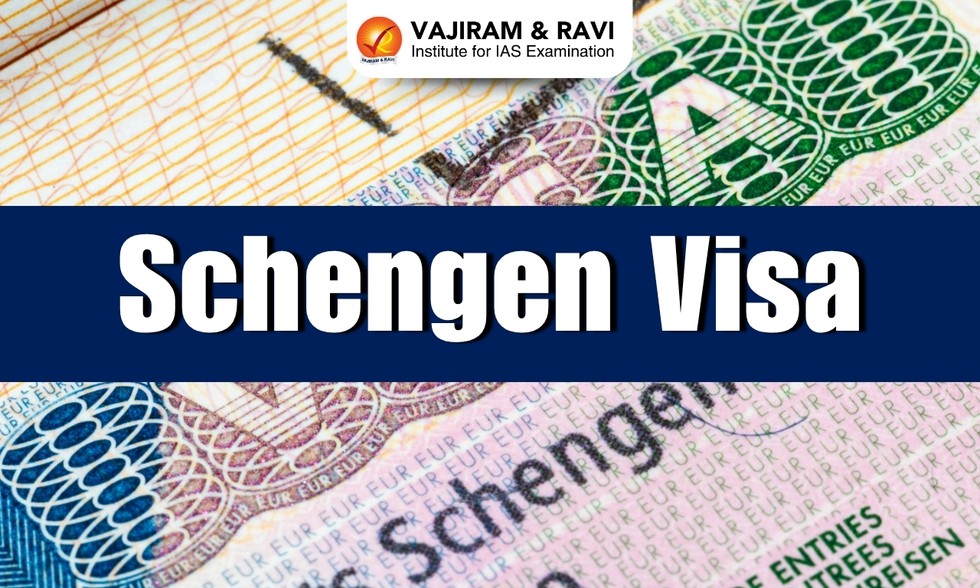
About Schengen Visa:
- A Schengen visa is an entry permit that allows non-EU nationals to temporarily visit or transit through the Schengen Area, which comprises 29 European countries.
- Within this area, there are no internal borders, allowing for unrestricted movement between the countries.
- The visa is valid for up to 90 days within a 180-day period, which begins the day you enter a Schengen country.
- You can enter and leave the area multiple times, but the total stay must not exceed 90 days within the 180-day period.
- Schengen visas are issued for various purposes, such as tourism, business, visiting family, medical treatment, and participation in cultural or sporting events.
- The visas do not give the right to work.
Which Countries Issue Schengen Visas?
- There are currently 29 European countries in the Schengen.
- Members of this area include 25 of the 27 EU member states (except for Cyprus and Ireland) and all members of the European Free Trade Association (Iceland, Liechtenstein, Norway and Switzerland).
- Being part of this area means that countries:
- Do not carry out checks at their internal borders, except in cases of specific threats;
- Carry out harmonized controls at their external borders, based on clearly defined criteria.
The Cascade Visa Scheme:
- The cascade visa scheme rewards “trusted travellers” with a documented travel record.
- Indian citizens who have obtained two Schengen visas within the past three years are now eligible for a two-year multi-entry visa.
- This can later be upgraded to a five-year visa, provided their passport is valid for the full term.
- During its validity, the visa allows holders to travel freely across the Schengen area, mirroring the travel rights of visa-free nationals.
- However, the visa does not grant the right to work and still limits stays to 90 days within any 180-day period.
- It applies a tiered structure for visa validity based on prior usage:
- 1-year visa if the traveller used three Schengen visas in the previous two years.
- 2-year visa if they used a 1-year multiple-entry visa in the previous two years.
- 5-year visa if they used a 2-year multiple-entry visa in the previous three years.
Prelims Pointers
July 31, 2025
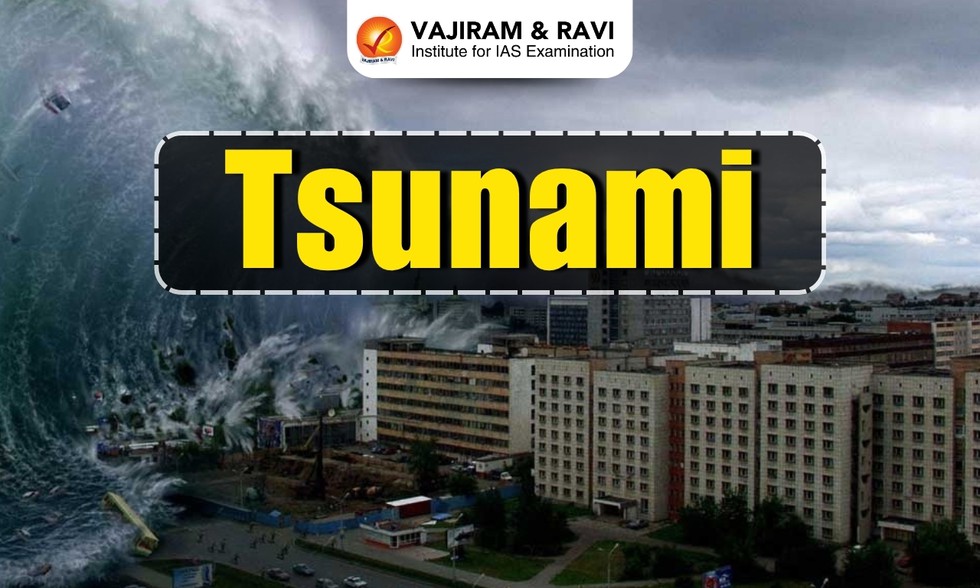
About Tsunami:
- A tsunami is a series of waves generated by a large and sudden displacement of the ocean.
- Tsunamis can have devastating and wide-ranging effects, especially in coastal regions.
- The word tsunami is composed of the Japanese words "tsu" (which means harbor) and "nami" (which means "wave").
- Large earthquakes below or near the ocean floor are the most common cause (about 80% of all known tsunamis are triggered by earthquakes), but landslides, volcanic activity, certain types of weather, and meteorites can also cause tsunamis.
- Not all earthquakes cause tsunamis; they must be strong and shallow (at least 6.5 magnitude and less than 70 km from the Earth’s surface), and move the seafloor vertically.
- Tsunamis radiate outward in all directions from their source and can move across entire ocean basins, around islands, and into bays, sounds, and up rivers.
- Out in the depths of the ocean, tsunami waves do not dramatically increase in height.
- But as the waves travel inland, they build up to higher and higher heights as the depth of the ocean decreases.
- The speed of tsunami waves depends on ocean depth rather than the distance from the source of the wave.
- Tsunami waves may travel as fast as jet planes over deep waters, only slowing down when reaching shallow waters.
- Tsunamis can have heights of up to 30 m (98 ft) and reach speeds of 950 km per hour.
- It is hard to see that a tsunami is approaching. The most obvious sign is when coastal water retreats just before the waves reach the shore. This is actually the trough of the wave following behind.
Prelims Pointers
July 31, 2025
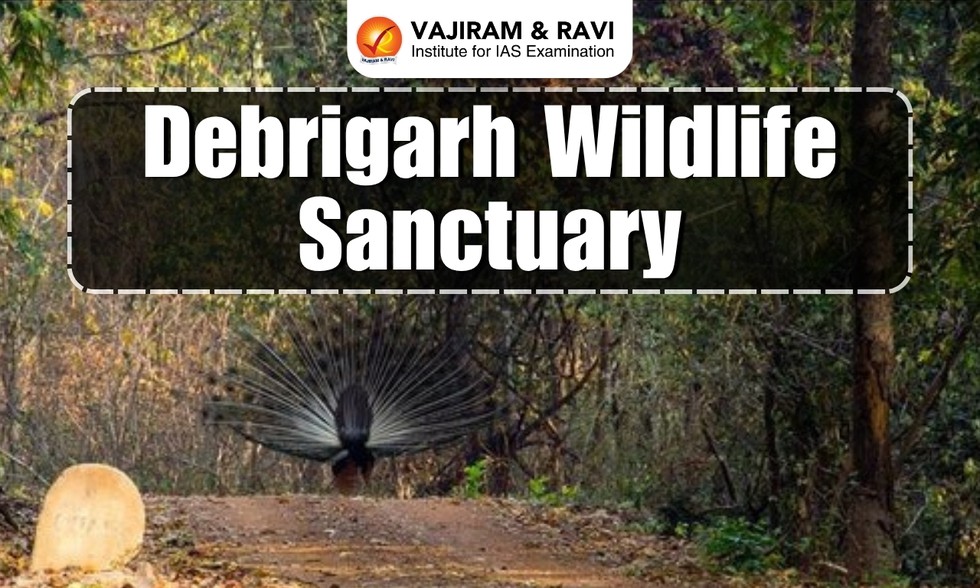
About Debrigarh Wildlife Sanctuary:
- Location: It is situated in the Bargarh district of
- It is located near Hirakud Dam on the Mahanadi River. It is the longest dam in India and the longest earthen dam in the world.
- It covers an area of nearly 347 sq.km.
- It was declared a wildlife sanctuary in 1985.
- It finds a special mention because of noted freedom fighter Veer Surendra Sai.
- During his rebellion against the British, his base at Barapathara was located within the sanctuary.
- Vegetation: Most of the plant sanctuary is covered with mixed and dry deciduous forest.
- Flora: Major trees found here are Sal, Asana, Bija, Aanla, Dhaura,
- Fauna:
- Indian leopards, sloth bears, chousingha (four-horned antelope), sambar deer, gaurs (Indian bison), wild boars, and Indian wild dogs (dholes) are among the notable animal residents.
- It is one of the most flocked wintering grounds of migratory birds that visit the sanctuary from far off places. Some of the most prominent among them are the crested serpent eagle, Flower Peckers, red vented bulbul, tree pie, drongo and white eye oriental.
Prelims Pointers
July 31, 2025
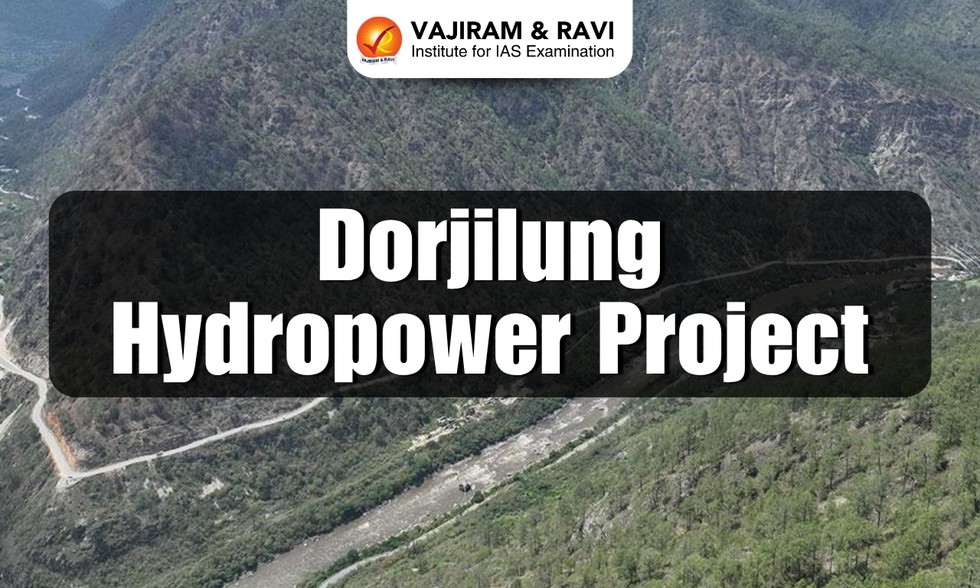
About Dorjilung Hydropower Project:
- It is a planned 1125 MW run-of-river project situated in the eastern Lhuentse and Mongar Districts of Bhutan on the Kurichhu River, a tributary of the Drangmechhu that flows into India.
- At a height of approximately 139.5 m, the concrete-gravity dam channels nearly 287 m3/s through a 15 km headrace tunnel to an underground powerhouse housing six Francis turbines, designed to generate around 4.5 terawatt-hours (TWh) annually.
- The total estimated cost of the project is $1.7 billion.
- The project is financed by the World Bank.
- In November 2024, Bhutan's Druk Green Power Corporation (DGPC) signed an MoU with Tata Power Company Limited for the joint development of the project under a Public-Private Partnership (PPP) model, with DGPC holding a 60% and Tata Power a 40% stake.
- The project is expected to be commissioned by early 2032.
Prelims Pointers
July 31, 2025
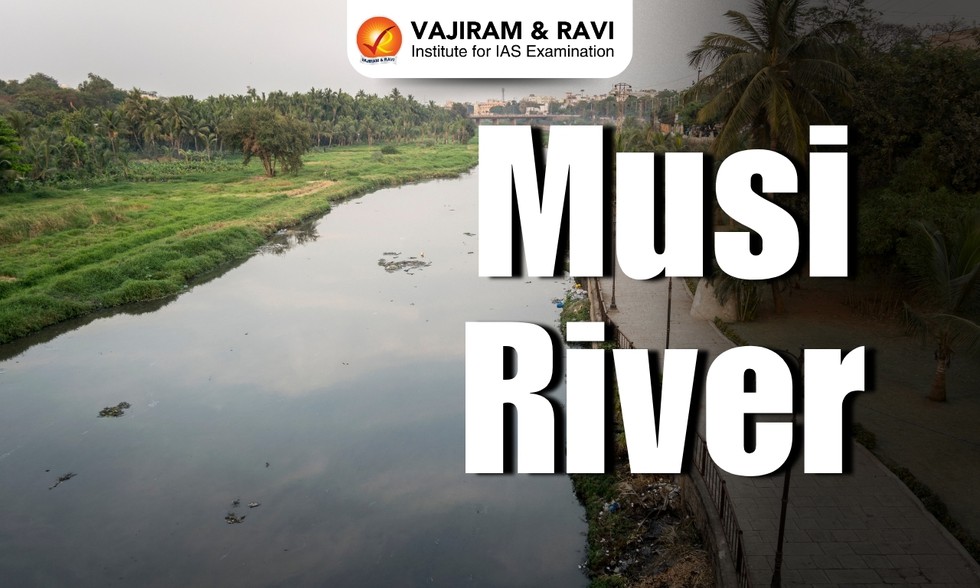
About Musi River:
- The Musi River, also known as the Muchukunda or Musunuru River, is a major tributary of the Krishna River in the Deccan Plateau, flowing through Telangana.
- Course:
- Source: Anantagiri Hills, Vikarabad, Telangana
- The river is formed by the merging of two small rivulets: Esi (8 km) and Musa (13 km).
- After originating, the Musi River flows in an eastward direction, cutting through the heart of Hyderabad city, where it historically divided the Old City from the New City.
- The river then continues its journey through the southern Telangana plains, passing through parts of Rangareddy and Nalgonda districts.
- Confluence: The Musi ultimately joins the Krishna River near Wazirabad in Nalgonda district.
- The river’s total length is approximately 240 kilometers.
- Dams: Himayat Sagar and Osman Sagar are the two dams that are constructed over the river.
- The Musi River has 24 diversion weirs for irrigation, locally known as kathwa
- Irrigation and drinking water for villages downstream is heavily polluted with waste from the city.
Prelims Pointers
July 31, 2025
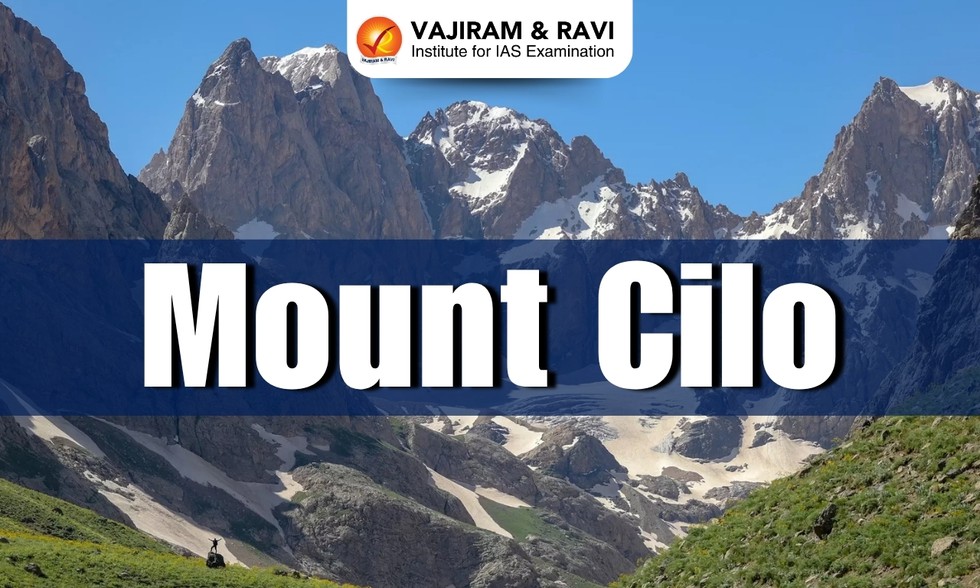
About Mount Cilo:
- Location: It is located southeast of Lake Van and the southeast end of the Taurus mountain range in the Anatolia region of
- The glaciers of Mount Cilo, which rises to 4,135 meters in the province of Hakkari on the Iraqi border, are the second largest in the country behind those of Mount Ararat (5,137 meters )
- It is the peak of the easternmost extension of the Taurus mountain range.
- It is situated in the Alpine-Himalayan Fold System and emerged as a result of the movement of the Arabian, Anatolian and Eurasian plates.
- Physical features of Mount Cilo
- It has five important high peaks. These; Uludoruk Peak, Suppa Durek Peak, Kosedireği Mountain, Kisara Mountain and Maunseli Sivrisi.
- The present shape of Cilo Mountain has been formed by tectonic movements and erosions.
- It has rugged topography with ridges, steep limestone cliffs, deep gorges, and glacial valleys.
- Impact of Climate Change: Turkey, which is experiencing heatwaves and drought, even registered a record temperature of 50.5C recently has been affecting glaciers.https://timesofindia.indiatimes.com/world/middle-east/turkeys-glaciers-fall-victim-to-climate-change/articleshow/122974030.cms
Prelims Pointers
July 31, 2025

About Skill Impact Bond:
- It is an innovative financing tool aimed at improving employment outcomes for young people,
- Under this initiative, first skills are provided to young people, and then jobs are provided to them or they are made capable to perform better within their current jobs.
- India’s Skill Impact Bond (SIB) was launched in November 2021.
- It is the country’s first development impact bond focused on employment.
- It is backed by the Ministry of Skill Development and Entrepreneurship through the National Skill Development Corporation,
- Its objective is to benefit 50,000 young Indians over four years, with 60% of the beneficiaries being women.
- This innovative outcomes-based financing tool uses private sector capital and expertise, focusing on job placement and retention rather than merely on training and certification.
- How does it work?
- There are ‘risk investors’ usually from the private sector who provide funding to service providers (organisations that deliver skills training and support job placement).
- Then there are outcome funders who repay the ‘risk investors’ if the programme has met its employment targets. There is also a third-party evaluator who verifies employment outcomes.
Prelims Pointers
July 31, 2025
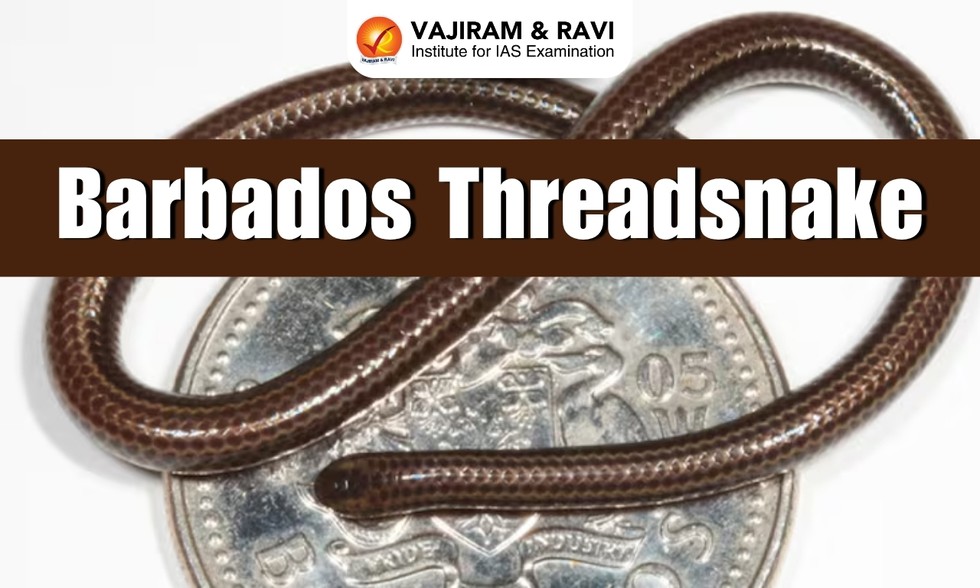
About Barbados threadsnake:
- It is a tiny snake belonging to the family Leptotyphlopidae.
- The snake is blind, burrows in the ground, eats termites and ants and lays one single, slender egg.
- Features of Barbados threadsnake
- It reaches a maximum adult length of only 10.4 cm (4.1 inches) and an average weight of 0.6 g (0.02 ounce), it is thought to be the world’s smallest known snake.
- They are solitary fossorial creatures adapted to burrowing.
- They are nocturnal and during the day usually hide under rocks.
- Due to their diet preferences, they are often found near ant and termite nests.
- The pheromones these snakes produce protect them from attack by termites.
- Habitat: Its habitat is most likely limited to the forests of eastern Barbados. They inhabit tropical dry forests.
- Distribution: Barbados threadsnakes are found on the Caribbean island of Barbados.
- Diet: Barbados threadsnakes are carnivores and their diets consist mostly of termite or ant larvae.
- Reproduction: They are oviparous meaning they lay eggs to reproduce.
- Conservation Status: Critically Endangered (IUCN Red List)
- Threats: Habitat loss is the main threat to the Barbados threadsnake.
Prelims Pointers
July 31, 2025

About Digital Payments Index:
- It has been constructed by the Reserve Bank of India to measure the extent of digitisation of payments across the country.
- It was first launched in January 2021.
- It is based on multiple parameters and reflects the expansion of various digital payment modes accurately.
- It is a first-of-its kind index to measure the spread of digital payments across the country.
- Base Year: It has been constructed with March 2018 as the base period, i.e., the DPI score for March 2018 is set at 100.
- The DPI index comprises five broad parameters that enable the measurement of deepening and penetration of digital payments in the country over different time periods. The parameters include:
- Payment enablers (25 per cent weightage in the index)
- Demand-side and supply-side payment infrastructure factors (10 per cent each)
- Payment performance (45 per cent)
- Consumer centricity (5 per cent)
- Each of the parameters has sub-parameters, which, in turn, consist of various measurable indicators.
Prelims Pointers
July 31, 2025

About CRIB Blood Group:
- It is part of the Cromer (CR) blood group system and, in recognition of its origin, has been officially named CRIB, with ‘CR’ representing ‘Cromer’ and ‘IB’ standing for ‘India’, ‘Bangalore’.
- This historic announcement was made at the 35th Regional Congress of the International Society of Blood Transfusion (ISBT) held in Milan, Italy.
- It is a new blood group, previously unidentified anywhere in the world.
- After ten months of research and molecular testing, international experts identified a new antigen in the Cromer (CR) blood group system.
- The blood group nomenclature is decided by the International Society of Blood Transfusion.
- Identifying new antigens like CRIB enhances global transfusion safety, improves compatibility testing, and lays the foundation for better donor matching in future medical emergencies.
- Cromer blood group system involves 12 high-prevalence and 3 low-prevalence antigens on decay-accelerating factor (DAF).
What are rare blood types?
- Rare blood type is when a person’s blood type is present in only 0.1% of the population.
- If a Rare type patient develops an antibody, they can only receive blood from another Rare Type donor.
- It poses serious challenges in emergency transfusions, organ transplants, and complex surgeries.
July 30, 2025
Prelims Pointers
July 30, 2025

About International Tiger Day:
- It is observed on July 29 each year.
- It serves as a platform to raise awareness about tiger conservation.
- It is celebrated worldwide to promote comprehensive efforts in safeguarding tigers and their natural habitats, fostering harmonious coexistence between humans and tigers.
- Theme of International Tiger Day 2025: “Securing the future of Tigers with Indigenous Peoples and Local Communities at the heart”.
- History of International Tiger Day:
- Global Tiger Day, commonly referred to as International Tiger Day, was established during the Saint Petersburg Tiger Summit in Russia in 2010.
- The summit brought together 13 tiger-range countries, including India, Bangladesh, Nepal, Bhutan, Malaysia, and Russia, following alarming reports that only around 3,000 tigers remained in the wild.
- The participating nations adopted the “Tx2” goal at the summit, which aimed to double the global tiger population by 2022 through joint conservation efforts and stronger protection laws.
- The 29th of July was chosen as International Tiger Day because it represents the halfway point between the first and last days of the Saint Petersburg Tiger Summit and the ongoing international campaign to rescue tigers.
Tiger Population in India:
- India now supports the world’s largest tiger population.
- While holding only 18% of the world’s tiger habitat, and facing the highest human density among tiger-range countries, India accounts for 75% of the world’s wild tigers.
- More than 3,600 tigers now roam the country’s forests, double the number recorded just over a decade ago.
- These tigers live across 138,200 sq.km. of forest, roughly half the size of the UK, often sharing the land with 60 million people.
- This success comes from decades of conservation efforts, particularly under a national initiative known as Project Tiger.
Prelims Pointers
July 30, 2025

About Chronic Traumatic Encephalopathy (CTE):
- It is a degenerative brain condition that happens after repeated head injuries.
- It causes the death of nerve cells in the brain, known as degeneration.
- CTE has been most commonly observed in athletes involved in contact sports such as American football, boxing, and hockey, as well as military veterans exposed to blast injuries.
- The condition typically develops years after repeated head trauma and worsens over time.
- Symptoms:
- Early symptoms may be mild or go unnoticed, often including depression or suicidal thoughts, aggression, mood swings, and personality changes.
- As the disease progresses, people may experience confusion, memory loss, and difficulty with planning or decision-making.
- In advanced cases, movement problems can also develop.
- Treatment: CTE cannot be cured, but medicines and other treatments can help your symptoms.
Prelims Pointers
July 30, 2025

About Mansa Devi Temple:
- It is a Hindu temple dedicated to the goddess Mansa Devi, a form of Shakti (Goddess Durga).
- It is located in the city of Haridwar in Uttarakhand.
- The temple is located atop the Bilwa Parvat on the Sivalik Hills, the southernmost mountain chain of the Himalayas.
- The temple, also known as Bilwa Tirth, is one of the Panch Tirth (Five Pilgrimages) within Haridwar.
- It is an epitome of the age-old tradition of ‘Shakti’ worship in Northern India.
- Maharaja Gopal Singh of Manimajra constructed the present main temple during the period 1811-1815.
- The temple complex is spread over an area of 100 acres.
- Built in a traditional North Indian style shape, the temple includes two important deities, Mansa Devi and her sister Chandi Devi.
Prelims Pointers
July 30, 2025

About Bigha:
- Bigha is a traditional unit of land measurement commonly used in India, Bangladesh, and Nepal.
- Popular in states where farming is common, it helps measure large agricultural land tracts as well as residential land.
- The states which use Bigha for land measurement are Haryana, Punjab, Rajasthan, Madhya Pradesh, Assam, Uttar Pradesh, Bihar, West Bengal, Gujarat, Himachal Pradesh, Jharkhand, and Uttarakhand.
- Historical Context:
- The origins of Bigha trace back to ancient South Asian practices.
- Before the introduction of modern units like the acre or hectare, landowners and farmers relied on Bigha to calculate land for cultivation, taxation, and trade.
- Over time, it became deeply rooted in the cultural and economic fabric of these regions.
- The exact measurement of bigha differs from state to state. For instance, in West Bengal and Assam, one bigha equals about 14,400 sq.ft., while in Punjab, it measures approximately 9,070 sq.ft.
- There is no national standard for the size of a bigha, and it is typically smaller than an acre, which is 43,560 sq.ft. or 4,047 sq.m.
- Bigha is common among farmers when measuring plots and negotiating land prices.
- A bigha is often divided into smaller subunits, such as ‘biswa’ , ‘katha’ and Nalli.
- Bigha in Bangladesh and Nepal:
- Bangladesh: Standardized under British rule at 14,400 square feet (1,340 square meters).
- Nepal: A bigha equals about 6,772.63 square meters, with local variations.
Prelims Pointers
July 30, 2025

About Exercise Divya Drishti:
- It is a high-altitude technology demonstration exercise conducted by the Indian Army in East Sikkim.
- It was designed to test new technologies that are designed to improve battlefield awareness, real-time surveillance, and quick decision-making.
- Troops from the Trishakti Corps, which is headquartered in Sukna on the outskirts of Siliguri, used a mix of ground-based systems and aerial platforms, including UAVs and drones, to create realistic battle scenes.
- A key highlight was the use of AI-enabled sensors linked with advanced communication systems.
- This setup ensures smooth and secure data flow among command centres, improves situational awareness, and enables faster and better decisions by creating a strong sensor-to-shooter link.
- The exercise was taken up to check out the army’s preparedness in using AI and some other modern technologies in a realistic battle situation.
Prelims Pointers
July 30, 2025

About SOFI Report 2025:
- It is an annual report prepared by five UN agencies: Food and Agriculture Organization (FAO), IFAD (International Fund for Agricultural Development), UNICEF (UN Children’s Fund), WFP (World Food Programme),and WHO (World Health Organization).
- It presents the latest data and analysis on hunger, food security and nutrition worldwide.
Key Highlights of SOFI Report 2025:
- Despite some recent progress, global hunger in 2024 remained well above pre-pandemic levels and even higher than in 2015.
- An estimated 96 million more people were suffering from chronic hunger today compared to 2015.
- It is now estimated that about 2.3 billion people in the world were moderately or severely food insecure in 2024.
- Asia accounted for the highest number of undernourished people at 323 million, followed by Africa (307 million) and Latin America and the Caribbean (34 million).
- Although hunger levels declined in Southeast Asia, Southern Asia, and South America, the report noted persistent or rising food insecurity in several other regions like Africa.
Prelims Pointers
July 30, 2025

About SOFI Report 2025:
- It is an annual report prepared by five UN agencies: Food and Agriculture Organization (FAO), IFAD (International Fund for Agricultural Development), UNICEF (UN Children’s Fund), WFP (World Food Programme), and WHO (World Health Organization).
- It presents the latest data and analysis on hunger, food security and nutrition worldwide.
Key Highlights of SOFI Report 2025:
- Despite some recent progress, global hunger in 2024 remained well above pre-pandemic levels and even higher than in 2015.
- An estimated 96 million more people were suffering from chronic hunger today compared to 2015.
- It is now estimated that about 2.3 billion people in the world were moderately or severely food insecure in 2024.
- Asia accounted for the highest number of undernourished people at 323 million, followed by Africa (307 million) and Latin America and the Caribbean (34 million).
- Although hunger levels declined in Southeast Asia, Southern Asia, and South America, the report noted persistent or rising food insecurity in several other regions like Africa.
Prelims Pointers
July 30, 2025

About Setubandha Scholar Scheme:
- It is the first national-level programme to formally integrate traditional scholars into the research ecosystem of IITs, without insisting on conventional degrees.
- It aims to bridge India's age-old gurukul tradition with modern scientific and academic inquiry.
- It is backed by the Ministry of Education and implemented by the Indian Knowledge System (IKS) division of the Central Sanskrit University (CSU),
- The scheme offers fellowships of up to Rs 65,000 per month across 18 interdisciplinary fields - from ayurveda to cognitive science, and architecture to political theory, grammar to strategic studies, performing arts to mathematics, physics, and health sciences.
- Eligibility: It is based on a minimum of five years of rigorous study in a recognised gurukul and demonstrable excellence in Shastras or traditional knowledge.
- The maximum age to apply is 32 years.
- Scholars selected under Category 1 (equivalent to postgraduate level) will receive a monthly fellowship of Rs 40,000 and an annual research grant of Rs 1 lakh.
- Those under Category 2 (equivalent to PhD level) will be awarded Rs 65,000 monthly and an annual grant of Rs 2 lakh.
- It is a major shift in India's education policy, opening up elite research pathways for scholars from non-formal backgrounds rooted in classical learning.
Prelims Pointers
July 30, 2025

About Mera Gaon Meri Dharohar Initiative:
- It is a pan-India initiative of Ministry of Culture under National Mission on Cultural Mapping and was launched on 27th July 2023.
- It was launched as part of ‘Azadi Ka Amrit Mahotsav’.
- The main objective of the project is to culturally map India's 6.5 lakh villages, spanning across all States and Union Territories, on a comprehensive virtual platform.
- The core idea behind this project is to encourage appreciation for India's culture and traditions, paving the way for economic growth, social harmony, and artistic development in rural communities.
- It is aimed at mapping India’s intangible cultural assets.
- The programme is being implemented by the Indira Gandhi National Centre for the Arts (IGNCA) under the National Mission on Cultural Mapping (NMCM).
- Under the MGMD, information is collected under seven broad categories as given below:
- Arts and Crafts Village
- Ecologically Oriented Village
- Scholastic Village linked with Textual and Scriptural Traditions of India
- Epic Village linked with Ramayana, Mahabharata and/or Puranic legends and oral epics
- Historical Village linked with Local and National History
- Architectural Heritage Village
- Any other characteristic that may need highlighting such as fishing village, horticulture village, shepherding village etc.
Prelims Pointers
July 30, 2025
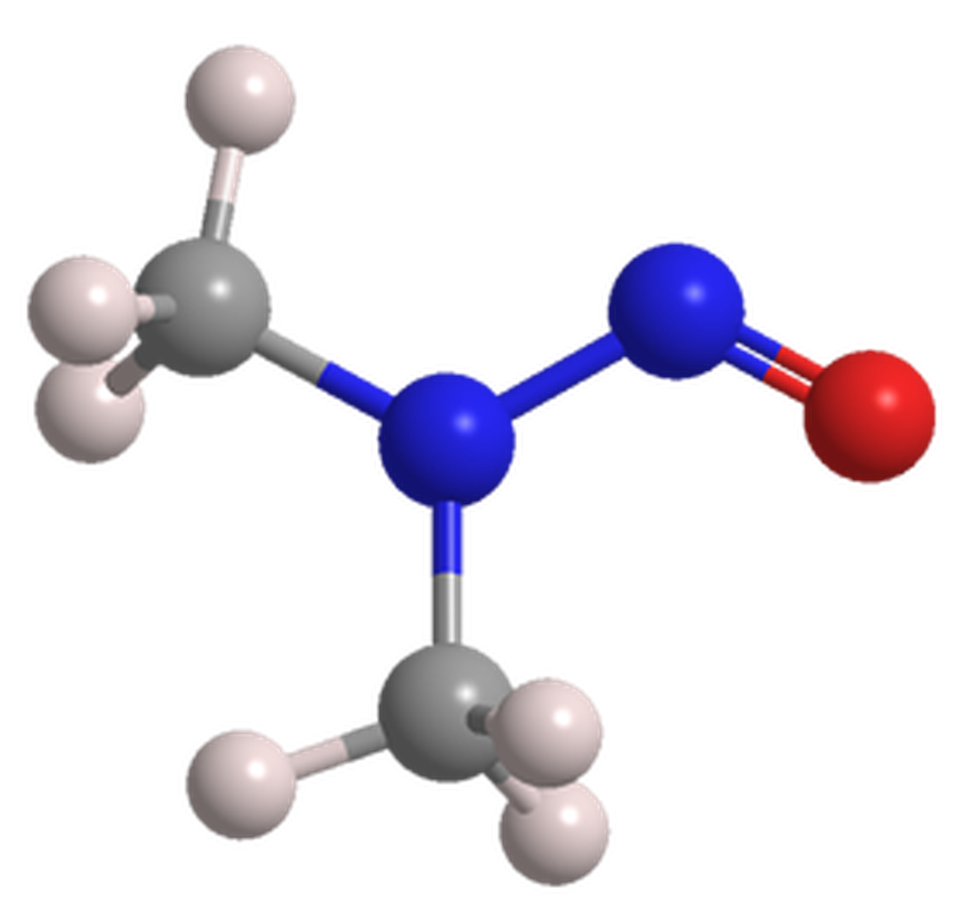
About N-Nitrosodimethylamine:
- It is a volatile organic chemical that occurs widely in the environment due to its ready formation from commonly found precursors.
- It is classified as a probable human carcinogen (a substance that could cause cancer) on the basis of animal studies.
- NDMA are formed when a secondary or tertiary amine reacts with a nitrite ion under acidic conditions.
- Features of N-Nitrosodimethylamine
- It is a yellow, odourless liquid chemical once used to make rocket fuel.
- It is also a byproduct of several manufacturing processes and water chlorination.
- NDMA breaks down when sunlight hits it.
- Normally, people are exposed to small amounts of NDMA in the environment and through food and water.
- Chemicals found in food and water, such as nitrosamines or alkylamines, can turn into NDMA in the stomach.
- NDMA is also created when food or drink is processed. Foods such as cured meats (particularly bacon), beer, fish, cheese and even vegetables may contain NDMA.
- Some people may have had exposure to NDMA through the use of contaminated medications
- Applications: Historically it was commercially used in the production of rocket fuel, antioxidants, softeners for copolymers, and additives for lubricants.
Prelims Pointers
July 30, 2025

About Pralay Missile:
- It is an indigenously-developed quasi-ballistic missile employing state-of-the-art guidance and navigation to ensure high precision.
- Features of Pralay Missile:
- It is a solid propellant quasi-ballistic missile.
- The missile is capable of carrying multiple types of warheads against various targets.
- Range: The missile has a range of 150-500 km and can be launched from a mobile launcher.
- Payload capacity: It has a payload capacity of 500-1,000 kg.
- The missile is capable of carrying conventional warheads.
- It is equipped with guidance systems that provide a Circular Error Probable (CEP) of less than 10 meters.
- The missile reaches terminal speeds of Mach 6.1 and can engage targets such as radar installations, command centers, and airstrips.
- It has the ability to change its path after covering a certain range midair.
- Developed by: It has been developed by Research Centre Imarat and in collaboration with other Defence Research & Development Organisation labs.
- Industry partners - Bharat Dynamics Limited & Bharat Electronics Limited and many other industries and MSMEs.
July 29, 2025
Prelims Pointers
July 29, 2025
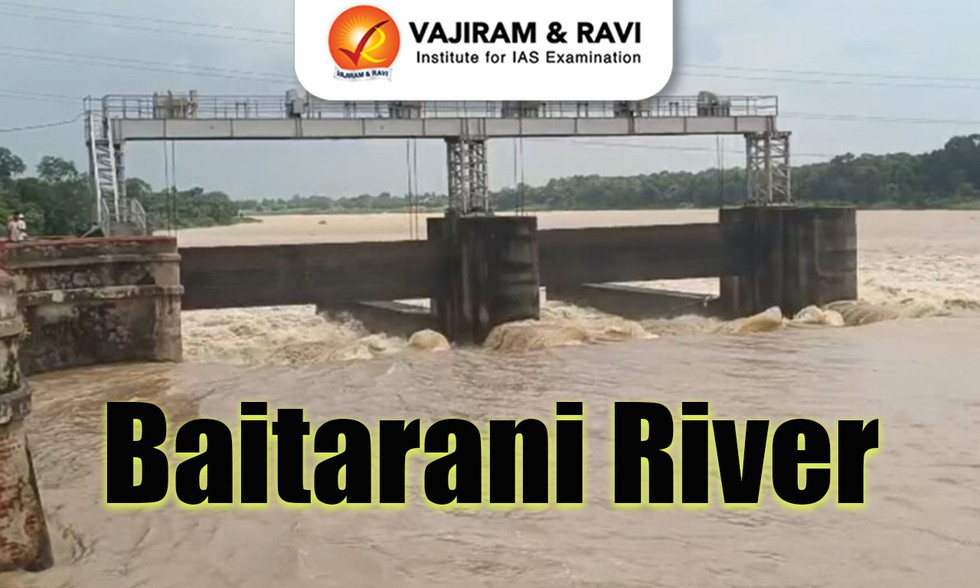
About Baitarani River:
- It is an important east-flowing river in eastern India, primarily flowing through Odisha and partially through Jharkhand.
- Baitarani, along with rivers like Mahanadi and Brahmani, forms a fertile delta.
- Course:
- Baitarani originates from the Gonasika Hills in Keonjhar district, Odisha, at an elevation of 900 meters above sea level.
- At its source, it first flows underground through a small stream called Guptaganga before emerging again, making the site sacred.
- The uppermost part of the river flows in a northerly direction.
- Then it changes its path and flows eastward.
- The beginning portion of Baitarani acts as the boundary between Odisha and Jharkhand.
- It travels approximately 360 km before draining into the Bay of Bengal.
- Total Basin Area: Approximately 12,790 sq. km.
- The River basin is geographically bounded by several important river basins and water bodies:
- South and West: Brahmani River basin
- North: Subarnarekha River basin
- East: Burhabalang River and the Bay of Bengal
- Major Tributaries:
- The river has 65 tributaries. Out of all the tributaries, 35 join from the left side and 30 join from the right side.
- Major tributaries include Salandi, Gahira, Kusei, Deo, Kanjhari, Musal, Arredi, Siri, Kukurkata, Budhi, Ambajhara, and Remal.
- The Baitarani basin possesses rich mineral and agricultural resources and thus offers an ideal ground for establishment of various industries.
Prelims Pointers
July 29, 2025

About Geosynchronous Satellite Launch Vehicle (GSLV):
- It is a space launch vehicle designed, developed, and operated by the Indian Space Research Organization (ISRO) to launch satellites and other space objects into Geosynchronous Transfer Orbits (GTOs).
- GSLV has the capability to put a heavier payload in orbit than the Polar Satellite Launch Vehicle (PSLV).
- GSLV is 49.13 m tall and the tallest among all other vehicles of ISRO.
- It is a three-stage vehicle with a lift-off mass of 420 tonnes.
- The first stage comprises an S139 solid booster with 138-tonne propellant and four liquid strap-on motors, with 40-tonne propellant.
- The second stage is a liquid engine carrying 40-tonne of liquid propellant.
- The third stage is the indigenously built Cryogenic Upper Stage (CUS) carrying 15-tonne of cryogenic propellants.
- The GSLV improves on the performance of the PSLV (Polar Satellite Launch Vehicle) by the addition of liquid strap-on boosters and a cryogenic upper stage.
- The solid first and liquid second stages are carried over from the PSLV, while the cryogenic upper stage is being supplied by Russia until India has developed an indigenous version.
Variants of GSLV:
- GSLV Mk I:
- The first-generation GSLV with a payload capacity of carrying 2-2.5 ton satellites to GTO.
- It used the Russian-supplied cryogenic upper stage, as it had early difficulty with mastering indigenous cryogenic technology.
- It conducted around 5 flights from 2001-2010, including suborbital tests, with the last launch in 2010.
- GSLV Mk II:
- It is an enhanced variant with an indigenously developed cryogenic upper-stage engine and stage.
- It is capable of carrying payloads to GTO around the 2.5-ton class.
- The first successful launch occurred in 2014.
- GSLV Mk III: The GSLV Mk III, also known as LVM-3, is the most advanced and powerful variant in the GSLV series, currently in service with a payload capacity of up to 4 tons to GTO.
- Performance of GSLV:
- The GSLV has launched various satellites, including communication satellites like INSAT and GSAT, as well as spacecraft from the NavIC and IDRSS series, into GTO.
- Notable missions include the launch of the South Asia Satellite in 2017, a satellite for military applications in 2018, and the Chandrayaan-2 moon mission in 2019.
Prelims Pointers
July 29, 2025
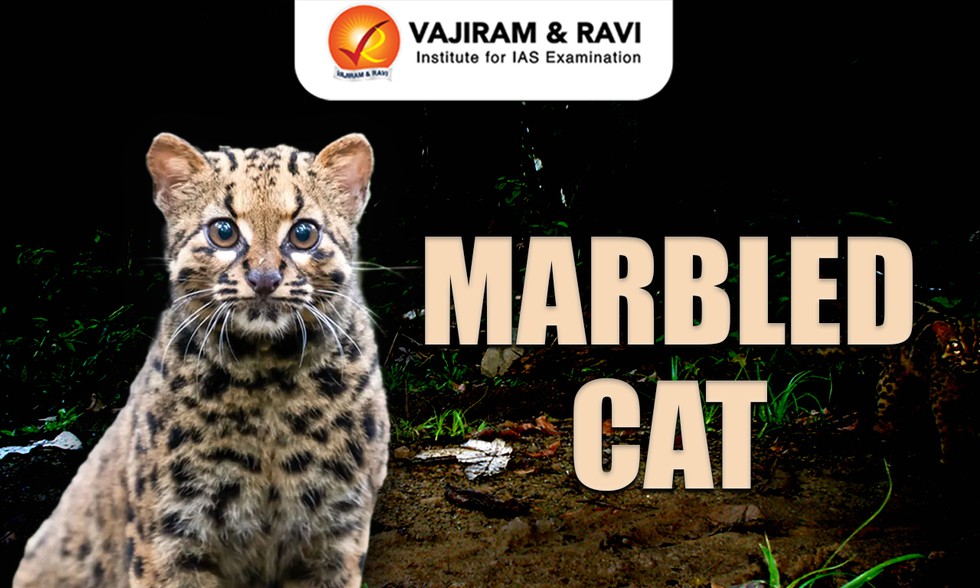
About Marbled Cat:
- It is a small wild cat of South and Southeast Asia.
- It is often referred to as a miniature version of the unrelated clouded leopard.
- Scientific Name: Pardofelis marmorata
- Distribution:
- Marbled cats range from the Eastern Himalayas to Upper Burma and the Indochinese region.
- This distribution includes areas of northern India, Nepal, Myanmar, Laos, Thailand, Vietnam, Cambodia, peninsular Malaysia, Sumatra, and Borneo.
- In India, the Indian marbled cat is primarily found in the forests of Northeastern states.
- Habitat:
- Marbled cats have been recorded in a variety of habitats from sea level to 3,000 meters.
- Habitats include mixed deciduous-evergreen forest, secondary forest, clearings, six-year-old logged forest, and rocky scrub.
- Features:
- It is about the size of a domestic cat. It measures roughly 45–60 cm (18–24 inches) long, excluding a tail of approximately the same length.
- The fur is full and soft with widely variable markings. The base color is brownish yellow, and the coat is covered in large blotches, which are paler in their centers and outlined in black.
- Large broken blotches occur on the flanks, and blackish lines occur on the head, neck, and back.
- These patterns tend to be smaller than in clouded leopards, and they merge together, resembling marble.
- They are known to be excellent climbers and are capable of leaping great distances between trees.
- They are solitary animals.
- They are nocturnal and may feed on small animals and birds.
- Conservation Status:
- IUCN Red List: Near Threatened.
Prelims Pointers
July 29, 2025
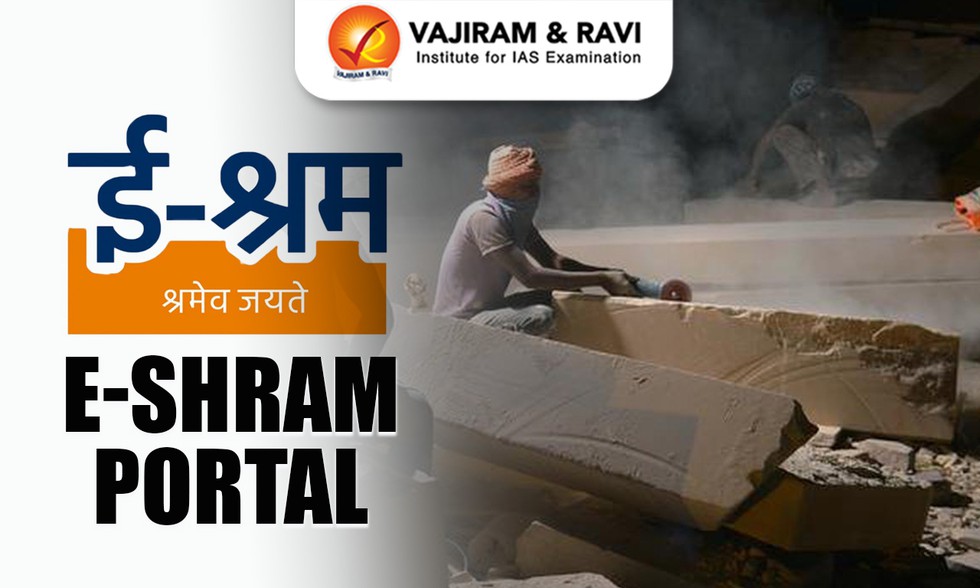
About e-SHRAM Portal:
- It was launched by the Ministry of Labour and Employment on 26th August 2021 to support and empower the unorganized workforce.
- It is designed to create a comprehensive National Database of Unorganised Workers (NDUW).
- It is the first-ever national database of unorganised workers including migrant workers, construction workers, gig and platform workers, etc.
- The Ministry of Electronics and Information Technology’s (MEITY’s) Bhashini project has been leveraged to upgrade the eShram portal with 22 languages. The previous version was available only in English, Hindi, Kannada, and Marathi.
- Objectives:
- Establish a centralized database of unorganized workers for effective policy implementation.
- Enhance access to social security schemes and benefits for workers in sectors such as agriculture, construction, domestic work, and street vending.
- Facilitate job matching and skill development
- Strengthen labor market resilience by integrating unorganized workers into the formal economy.
- Promote financial inclusion through direct benefit transfers and digital payments.
- Eligibility for Registering on E-Shram Portal:
- Be aged between 16 and 59 years.
- Be employed in the unorganized sector, including self-employed individuals, daily wage laborers, and gig workers.
- Possess an Aadhaar card, a valid mobile number linked to Aadhaar, and a bank account.
- Not be a member of the Employees' Provident Fund Organization (EPFO) or Employees' State Insurance Corporation (ESIC).
- Features:
- Universal Account Number (UAN): Registered workers receive a UAN linked to their Aadhaar, enabling seamless access to benefits.
- Single Registration Process: The portal streamlines the registration process, requiring minimal documentation such as Aadhaar and bank account details. The ease of self-registration is also available to the beneficiaries.
- Multilingual Support: Workers from diverse regions can access the portal in multiple Indian languages, ensuring inclusivity.
- Grievance Redressal Mechanism: A dedicated helpline and support system address workers’ queries and grievances promptly.
- Integration with Employment and Skill Opportunities: Registered workers can connect with employment opportunities, skilling, apprenticeship, pension schemes, digital skilling, and state-specific schemes through the portal.
- Family Details for Migrant Workers: Family details for migrant workers are captured, aiding in the provision of child education and women-centric schemes for those who have migrated with their families.
- Data Sharing with BOCW Welfare Boards: The data of construction workers registering on e-Shram is shared with the concerned Building and Other Construction Workers’ (BOCW) Welfare Boards, ensuring their registration with the respective boards and access to schemes meant for them.
- Data Sharing Portal (DSP): A Data Sharing Portal has been launched to allow the secure sharing of e-Shram beneficiary data with State and Union Territory governments. facilitating the targeted implementation of social security and welfare schemes for registered unorganised workers.
Prelims Pointers
July 29, 2025
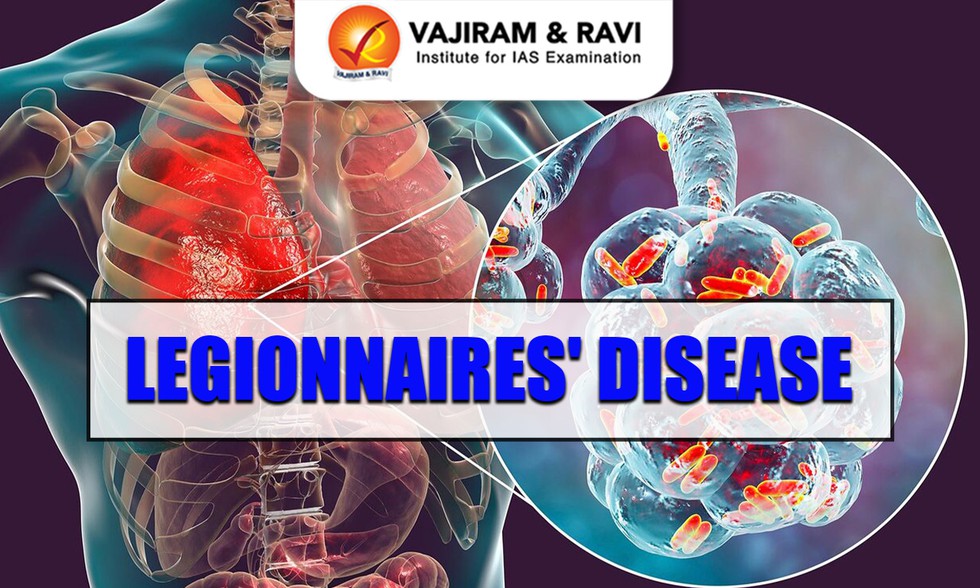
About Legionnaires' Disease:
- It is a severe form of a lung infection called pneumonia.
- It is caused by a bacterium known as legionella.
- Transmission:
- Legionella is found naturally in freshwater, such as lakes and rivers. It can also be found in soil.
- Most people who catch Legionnaires' disease breathe in the bacteria from water or soil.
- You usually can't get infected by drinking water that contains the bacteria unless you aspirate it (accidentally breathe the water into your lungs).
- It is not contagious, meaning it is not spread from person to person.
- Older adults, people with weakened immune systems, and people who smoke have a higher risk of getting Legionnaires' disease.
- Symptoms:
- The main symptoms are fever, chills, headache, malaise, and muscle pain (myalgia).
- Untreated Legionnaires' disease can kill.
- Treatment:
- Treating right away with antibiotics most often cures Legionnaires' disease.
- But some people still have problems after treatment.
Prelims Pointers
July 29, 2025
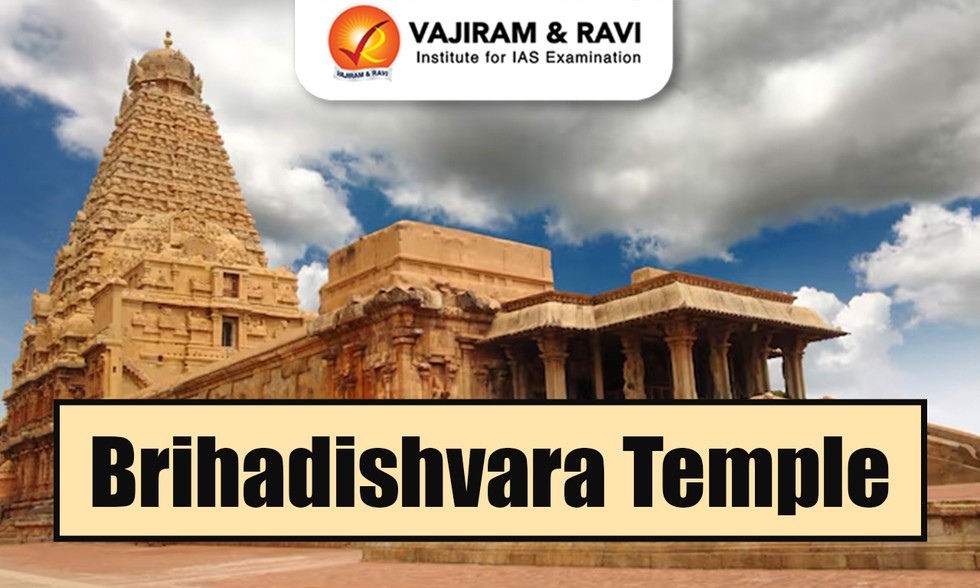
About Brihadisvara Temple:
- It is also known as Peruvudaiyar Kovil is located in Thanjavur, Tamil Nadu.
- It is dedicated to Lord Shiva represented as a huge ‘Lingam’.
- The temple was built around 1010 AD by the Chola king Rajaraja Chola I.
- It is revered as one of the three 'Great Living Chola Temples,' alongside the Gangaikondacholeeswaram Temple and Airavatesvara Temple, and is a UNESCO World Heritage Site.
- It has been regarded as a ‘landmark in the evolution of building art in south India’ and its vimana as a ‘touchstone of Indian architecture as a whole’.
- Key features of Brihadisvara Temple
- It is a Dravidian architecture styled temple.
- The temple’s pyramidal vimanastands more than 200 feet (60 meters) high and represents Mount Meru, the mythical mountain at the center of the universe in Hindu cosmology.
- The sikhara, a cupolic dome, is octagonal and rests on a single block of granite, a square of 7.8 m weighing 80 tons.
- One of the temple's most captivating features is the grand statue of Nandi, the sacred bull of Lord Shiva.
- Its inscriptions and frescoes narrate the tale of the rise and decline of the city’s fortunes.
Prelims Pointers
July 29, 2025
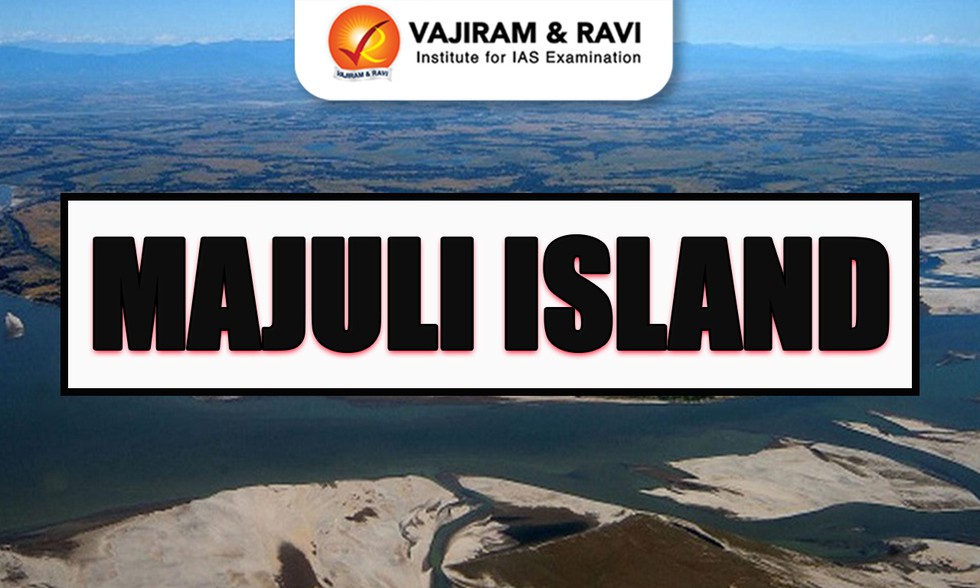
About Majuli Island:
- It is the world’s largest river island located in Assam.
- The island is formed by the Brahmaputra River in the south and the Kherkutia Xuti, a branch of the Brahmaputra, joined by the Subansiri River in the north.
- Most of the islanders belong to three tribes-Mishing, Deori and Sonowal Kachari, with the non-tribal Assamese comprising the rest.
- The island’s landscape is characterised by lush greenery, water bodies and paddy fields.
- Rice cultivation is the primary livelihood for the residents of Majuli, with several unique varieties of rice, such as Komal Saul and Bao Dhan, grown in the region.
- The island has also been the hub of Assamese neo-Vaishnavite culture, initiated around the 16th century by the great Assamese saint-reformer Srimanta Sankerdeva and his disciple Madhavdeva.
- They initiated the tradition of Satras (monastic institutions), and these Satras have preserved Sattriya dance, literature, bhaona (theatre), dance forms, mask making, and boat-making.
- Apart from Satras or Vaishnavite monasteries, Majuli is famous for mask-making and has a tradition of pottery making.
Prelims Pointers
July 29, 2025
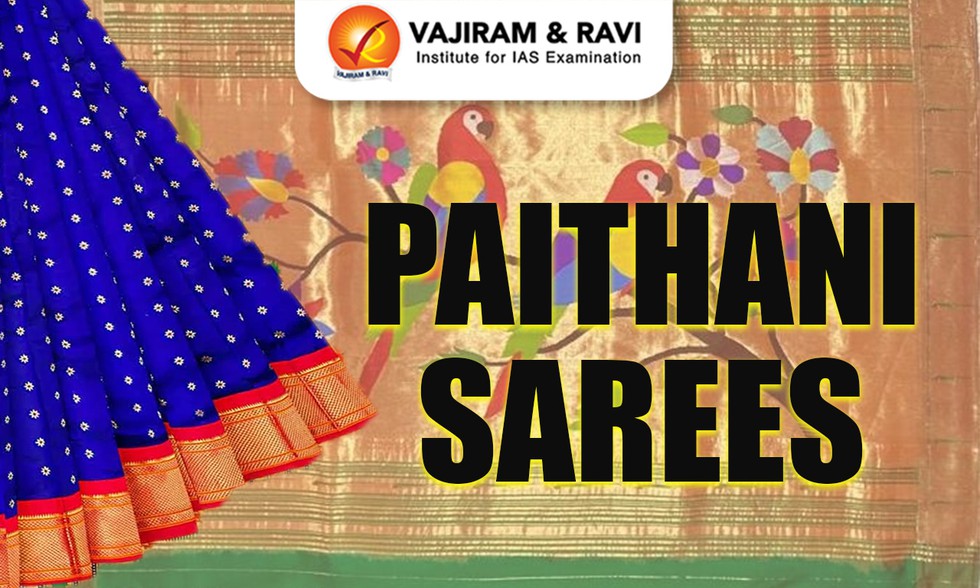
About Paithani Sarees:
- It is known as the ‘mahavastra of the state of Maharashtra’.
- It is known for its rich, vibrant colors woven in pure silk and gold zari.
- The birthplace of Paithani, is the medieval town of Paithan, located on the banks of the River Godavari.
- Features Paithani Sarees
- The traditional Paithani saree is manufactured by hand in pure silk and dyed in traditional colours.
- Its kath (border) and padar (pallu or end-piece), have distinctive motifs that make the textile stand out.
- The traditional motifs used in Paithanis include parrots, lotuses and peacocks. The six- or nine-yard sari has been favored by Maharashtrian brides for centuries.
- It was awarded with the Geographical Indication (GI) tag in 2010.
- Paithanis are easily recognizable and considered among the most exquisite and expensive sarees in India.
- These sarees are made using the finest silk available in the country and are regarded as a symbol of Maharashtrian heritage and skilled craftsmanship.
Prelims Pointers
July 29, 2025
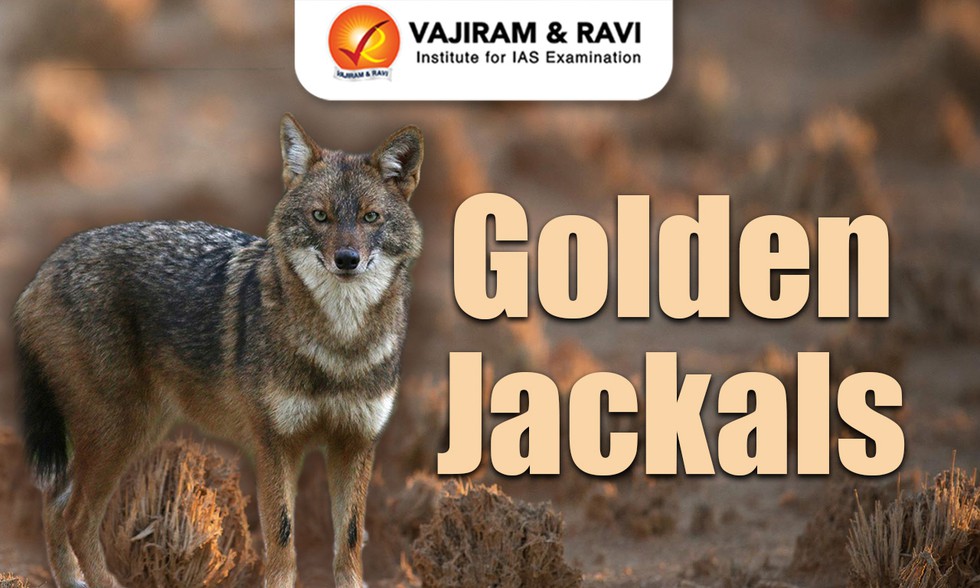
About Golden Jackal:
- It is also known as the common jackal and is a medium-sized wolf-like canid.
- It is strictly nocturnal in areas inhabited by humans, but may be partly diurnal elsewhere.
- It digs caverns for shelter, or uses crevices in rocks, or caverns that were dug by other animals.
- It lives in mated pairs and is strictly monogamous.
- Diet: It is omnivorous.
- Habitat: It is abundant in valleys and along rivers and their tributaries, canals, lakes, and seashores, but is rare in foothills and low mountains.
- Distribution: North and East Africa, Southeastern Europe and South Asia to Burma.
- It is quite widespread across India. Right from the Himalayan foothills, down to the Western Ghats, the Golden Jackal has a wide distribution.
- Conservation Status
- IUCN: Least Concern
- CITES: Appendix III
- Wildlife Protection Act, 1972: Schedule I.
Prelims Pointers
July 29, 2025
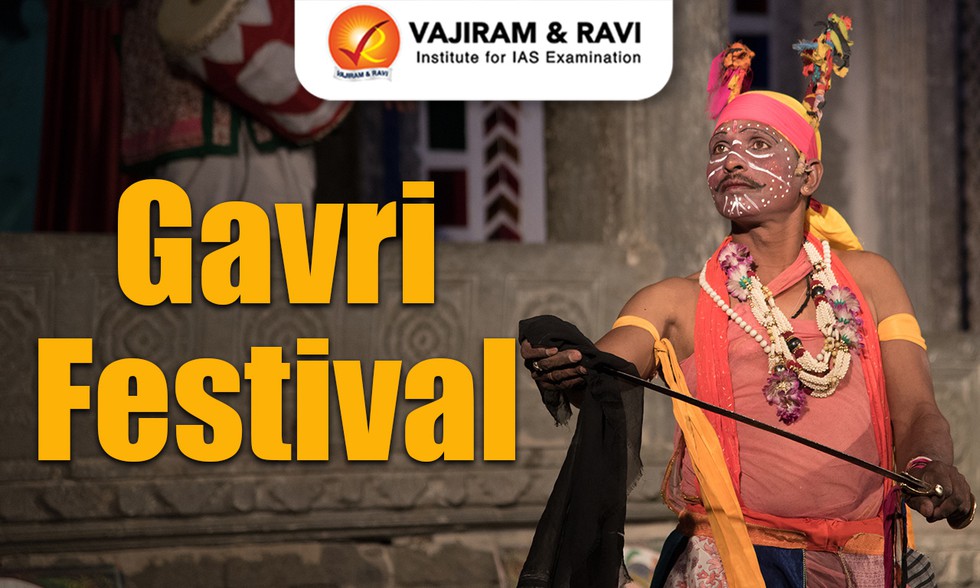
About Gavri Festival:
- It is a 40-day festival of dance-drama which is performed by the Bhil community of Rajasthan.
- It is a fusion of act and dance, dedicated to the fight between goddess and demon.
- This most popular southern Rajasthani ritual reflects the divine perception of the Bheel tribe.
- It has been known to be in existence since the 3rd or 4th century, it was prevalent in the times of Siddh Raj Jai Singh, a ruler in Gujarat.
- A vigorous fight between Goddess Amba and Demon Bhiamwal shows the conquest of good over the bad.
- The original story of ‘Gavri’ is the story of Lord Shiva and the demon Bhasmasur.
- The artists perform plays in those villages where their married sisters and daughters reside. The purpose behind this custom is to ensure the wellness of their loved ones after marriage and instill in them a sense of pride and security.
- This dance drama skillfully combines mime and dialogue, known by the names Gavri or Rai Nach.
- Moreover, energetic background music and colorful costumes makes the place full of verve.
- Throughout the performance, various scenes are enacted, referred to as Khel.
- Kutkadiya, a character skillfully narrates the story before each scene, allowing the audience to immerse themselves fully in the play’s narrative.
- All the characters are played by men and not women.
July 28, 2025
Prelims Pointers
July 28, 2025
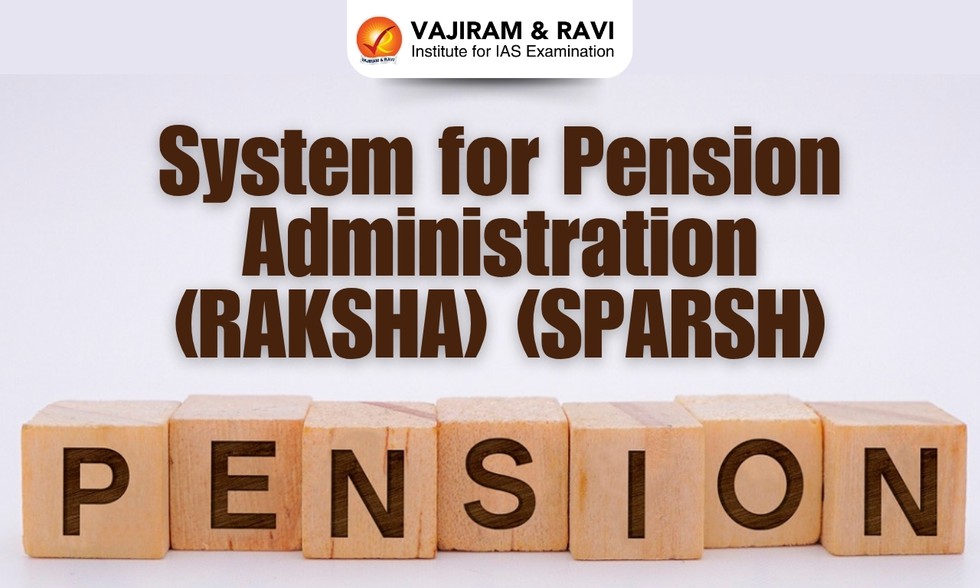
About System for Pension Administration (RAKSHA) (SPARSH) :
- It is an initiative of the Ministry of Defence, Government of India.
- Objective: Meeting the pension sanction and disbursement requirements for Armed Forces Army, Navy, Air Force and Defence Civilians.
- It is administered by the Defence Accounts Department through the Principal Controller of Defence Accounts (Pensions), Prayagraj and shall cater to all the three Services and allied organisations.
- Without relying on a third-party intermediary, this web-based system handles pension claims, and deposits pension payments into the bank accounts of defence pensioners.
- It is a centralized sanction, claim and pension disbursement system with easy validation and rectification of data through self-verification.
- It uses a digital process for pensioner identification, removing the requirement of multiple visits by pensioners to the pension offices.
- The defence pensioner will be given a completely transparent view of his pension account through this platform.
- It will capture and maintain a complete history of events and entitlements the pensioner right from the date of commencement of pension to the date of cessation of pension due to his/her last eligible beneficiary.
- The system would cater to all activities of the pension cycle namely:
- Initiation and Sanction
- Disbursement
- Revision
- Service and Grievance Request Management.
Prelims Pointers
July 28, 2025
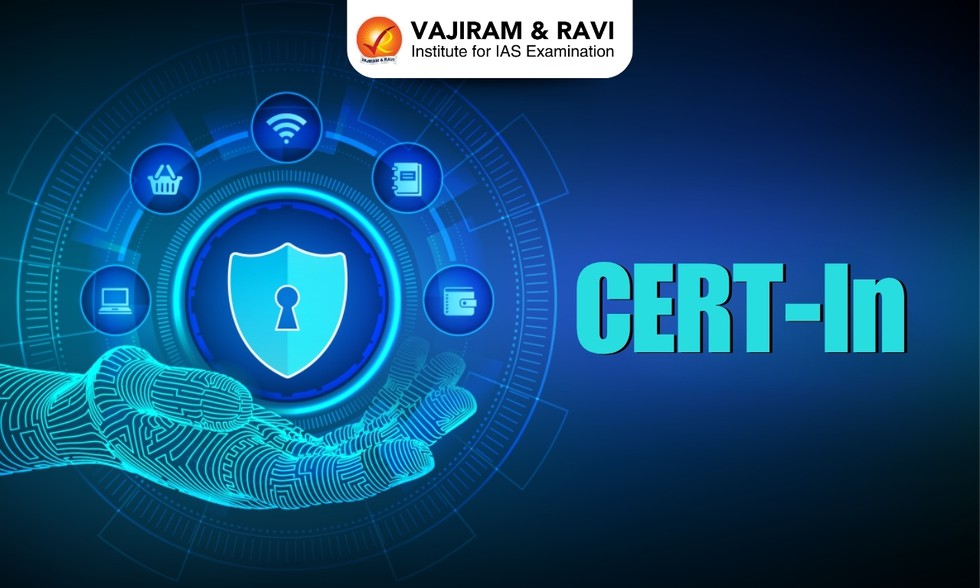
About Indian Computer Emergency Response Team (CERT-In):
- It is the national nodal agency for responding to computer security incidents as and when they occur.
- It is a functional organisation of the Ministry of Information & Electronics Technology, Government of India.
- Objective: Securing Indian cyberspace.
- The constituency of CERT-In is the Indian cyber community and Indian cyberspace.
- CERT-In has been designated under Section 70B of the Information Technology Act, 2000, to serve as the national agency to perform the following functions in the area of cyber security:
- Collection, analysis, and dissemination of information on cyber incidents.
- Forecasts and alerts of cybersecurity incidents.
- Emergency measures for handling cybersecurity incidents.
- Coordination of cyber incident response activities.
- Issue guidelines, advisories, vulnerability notes, and white papers relating to information security practices, procedures, prevention, response, and reporting of cyber incidents.
- Such other functions relating to cyber security as may be prescribed.
- To perform these functions, CERT-In is empowered to call for information and issue directions to service providers, intermediaries, data centres, body corporates, and any other person.
- CERT-In provides services to organizations in the Government, Public, and Private sectors. In addition, CERT-In provides services to individuals and home users as well.
- CERT-In collaborates with international counterparts to share information regarding emerging threats, vulnerabilities, and malware.
- Disclosure of information will be followed in accordance with Indian Constitutional laws.
- Key Projects:
- Cyber Swachhta Kendra (www.csk.gov.in)
- National Cyber Coordination Centre (NCCC)
- Cyber Threat Intelligence Sharing Platform
- Cyber Abhyas Suvidha (CAS) Advanced Skill Development Platform.
Prelims Pointers
July 28, 2025

About Exercise Drone Prahar:
- It is a high-tech military drill conducted by the Indian Army to validate the integration of drone technology into tactical battlefield operations.
- It was conducted at the military station at Rayang in Arunachal Pradesh's East Siang District.
- Carried out under realistic operational conditions, the exercise demonstrated the effective use of drones for intelligence, surveillance, and reconnaissance, as well as real-time sensor-to-shooter coordination and precision targeting.
- The aim was to enhance command reach and improve situational awareness for tactical commanders by employing layered surveillance and supporting dynamic decision-making on the ground.
- The exercise also evaluated critical aspects necessary for seamless drone integration in battlefield scenarios.
- This included testing of airspace deconfliction, ensuring secure communication channels, and establishing coordination protocols among various arms and services.
Prelims Pointers
July 28, 2025
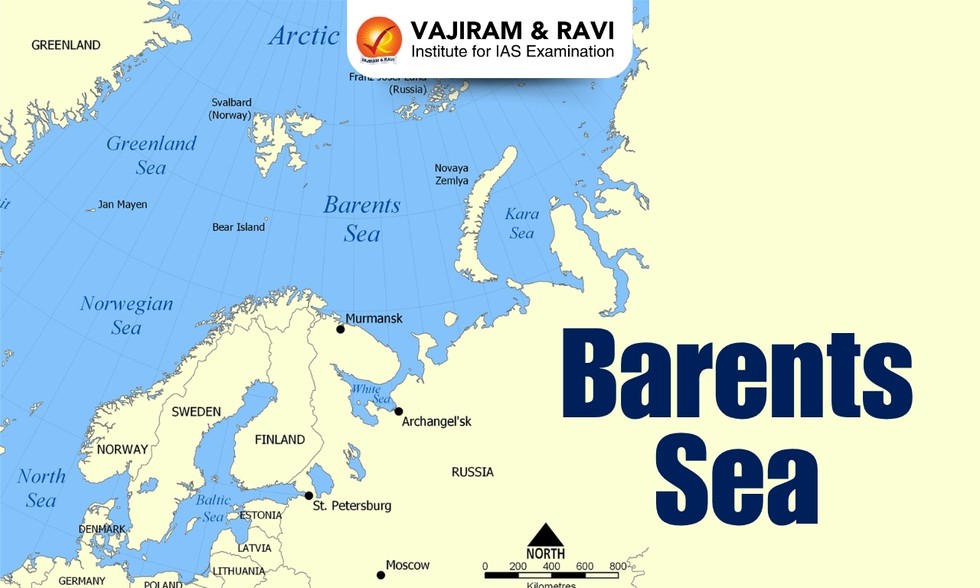
About Barents Sea:
- It is a marginal sea of the Arctic Ocean located along the northern coasts of Norway and Russia.
- It covers an area of 1.4 million sq.km.
- It was named for Willem Barents, a 16th-century Dutch navigator who explored it while searching for a northeast passage to Asia.
- The sea was known to Vikings and medieval Russians as the Murmean Sea.
- Boundaries:
- It is bounded by the Svalbard archipelago in the northwest, the Franz Josef Land islands in the northeast, the Novaya Zemlya archipelago in the east, the Norwegian Sea and the Greenland Sea in the west, and by the Kola Peninsula in the south.
- It is separated from the Kara Sea by the Kara Strait and the Novaya Zemlya archipelago.
- The White Sea and the Pechora Sea are two parts of the Barents Sea.
- The White Sea is a southern arm of the Barents Sea, which separates the Kola Peninsula from the Russian mainland.
- The Pechora Sea is situated in the southeastern part of the Barents Sea.
- The maximum width of the Barents Sea is 1,050 km, and it is about 1,300 km in length.
- It covers a relatively shallow continental shelf fringing the Eurasian landmass.
- It has an estimated average depth of 230 m.
- The climate of the sea is subarctic.
- The waters of the Barents Sea have a high salinity of 34 parts per 1,000.
- The Gulf Stream keeps the Barents Sea and its adjoining coasts significantly warmer than other sub-Arctic regions.
- It has a rich biological diversity, including some of the world’s most numerous colonies of seabirds such as puffins and guillemots, rich seafloor communities with kelp forests, numerous deepwater coral reefs, and a unique variety of marine mammals such as walrus, bowhead whales, and polar bears.
Prelims Pointers
July 28, 2025
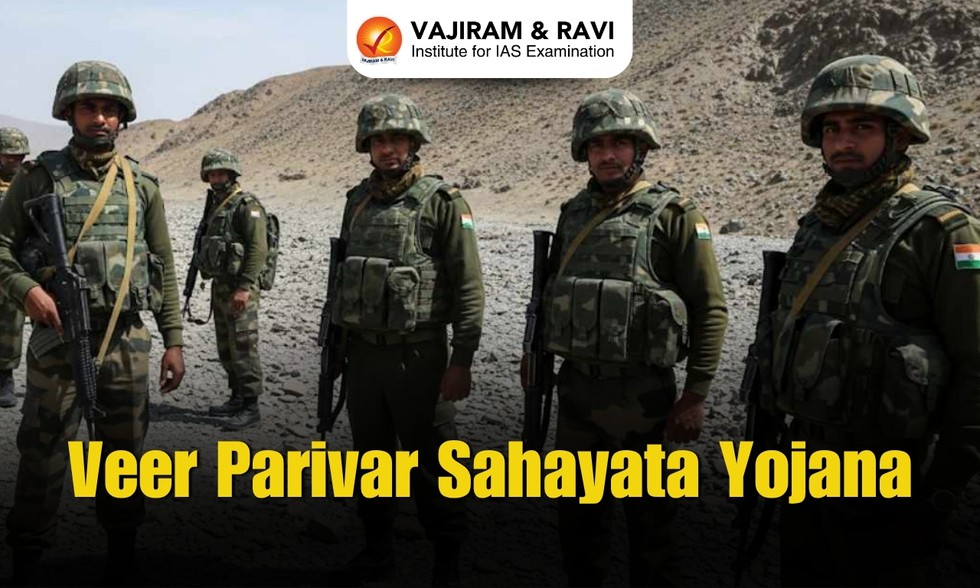
About Veer Parivar Sahayata Yojana:
- It is a joint initiative of the National Legal Services Authority (NALSA), the Kendriya Sainik Board (KSB), Rajya Sainik Boards (RSBs), and Zilla Sainik Boards (ZSBs), under the Department of Ex-Servicemen Welfare, Ministry of Defence.
- Objective: Providing free and competent legal services to defence personnel, ex-servicemen, and their families.
- It will be implemented through a nationwide network of Legal Services Clinics established across Rajya and Zila Sainik Boards in all states and union territories.
- These clinics will operate in close collaboration with the Department of Ex-Servicemen Welfare, Ministry of Defence and respective Directorates of Sainik Welfare.
- The scheme is especially relevant for personnel posted in remote locations who often find it difficult to appear in court or follow up on legal matters involving family property, land disputes, or domestic issues.
- Through this initiative, NALSA will facilitate proper legal representation in such cases across the country.
- Panel lawyers and paralegal volunteers of the legal services authority will provide free legal aid to soldiers.
- The support will also extend to paramilitary personnel, including those from the Border Security Force (BSF), Central Reserve Police Force (CRPF), Indo-Tibetan Border Police (ITBP), and others who serve in similarly isolated and high-risk conditions.
Prelims Pointers
July 28, 2025
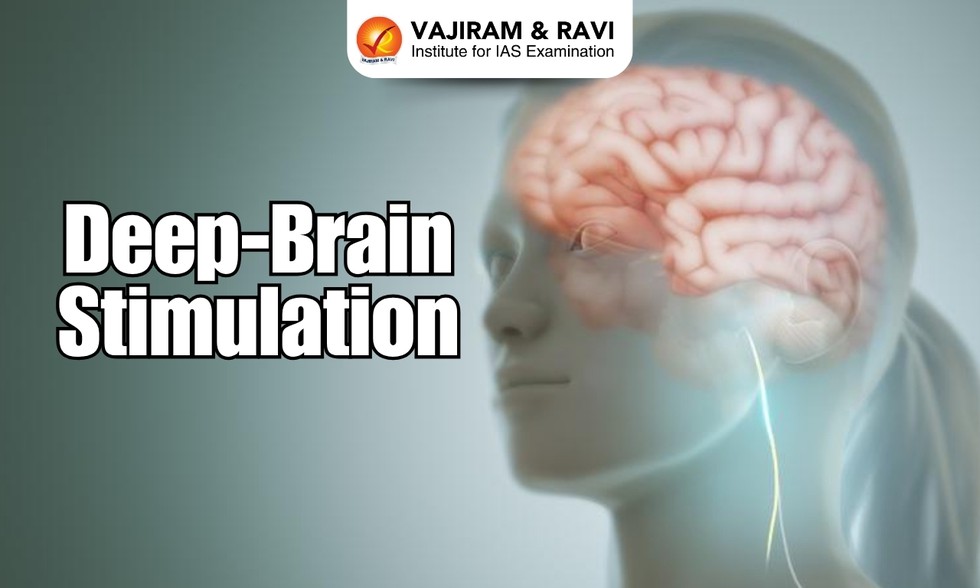
About Deep-Brain Stimulation:
- It is a medical technique where doctors implant electrodes deep inside specific areas of the brain to treat certain disorders.
- How does it work?
- These electrodes are connected by wires to a small device, similar to a heart’s pacemaker, which is usually placed under the skin in the upper chest.
- The device sends controlled, mild electrical impulses to targeted brain regions, helping adjust abnormal brain activity or chemical imbalances.
- Application of Deep-Brain Stimulation:
- DBS is most commonly used for movement disorders, especially in people with Parkinson’s disease, essential tremor, and dystonia, whose symptoms no longer respond well to medication.
- It has also been approved for some psychiatric conditions like obsessive-compulsive disorder, and is being studied for severe depression and epilepsy.
- DBS works by modifying how groups of neurons talk to each other. Many of these disorders involve faulty electrical signals in the brain.
- Delivering electrical pulses through DBS can interrupt these erratic signals, helping reduce symptoms such as tremors or muscle stiffness.
- Advantages of DBS
- One advantage of DBS is that, unlike brain surgery that destroys tissue, its effects are reversible: if you turn off the device, the stimulation stops.
- It is believed to help normalise disrupted brain circuits at both the cellular and network levels.
Prelims Pointers
July 28, 2025

About World Food India:
- The first edition was held in 2017, followed by a successful second edition in 2023 and the third in 2024.
- It is a gateway to the Indian food economy and an opportunity to showcase, connect, and collaborate.
- It is organized by the Ministry of Food Processing Industries, Government of India,
- It is the largest gathering of investors, manufacturers, producers, food processors, policy makers, and organizations from the global food ecosystem.
- It aims to provide opportunities for both investment and trade in the food processing sector for leading Indian and international companies.
- WFI serves as a premier platform for stakeholders from across the world to connect, collaborate, and explore opportunities in India's dynamic food processing landscape. Building on the remarkable success of previous editions,
- Theme of WFI 2025: “Processing for Prosperity”
- The food processing sector is a priority under the Make in India initiative, with the Ministry of Food Processing Industries implementing schemes to attract investment and develop infrastructure.
- Mega Food Parks with essential utilities and common processing facilities are being established in agriculturally rich areas, offering a plug-and-play model for entrepreneurs.
Prelims Pointers
July 28, 2025

About TRACERS Mission:
- The Tandem Reconnection and Cusp Electrodynamics Reconnaissance Satellites (TRACERS) will help understand magnetic reconnection and its effects in Earth’s atmosphere.
- It will fly in low Earth orbit through the polar cusps, funnel-shaped holes in the magnetic field, to study magnetic reconnection and its effects in Earth's atmosphere.
- This twin satellite system is set to study the constant stream of solar wind and charged particles flowing from the Sun, which interacts with Earth’s magnetic shield, also known as the magnetosphere.
- Significance: The data gathered from TRACERS will help scientists improve space weather forecasting and better protect critical technology here on Earth.
What is magnetic reconnection?
- When the solar wind hits this magnetic field, it can lead to magnetic reconnection, which also releases a huge amount of energy.
- As the solar wind collides with Earth’s magnetic field, this interaction builds up energy that can cause the magnetic field lines to snap and explosively fling away nearby particles at high speeds.
- These reconnection events can cause beautiful light shows like auroras, but also cause problems for satellites, astronauts, and GPS systems.
- Over the first year alone, the mission is expected to get information on more than 3,000 such reconnection events.
- The twin satellites will do this while orbiting through Earth’s polar cusp region, funnel-like openings in the magnetic field where the solar wind has a direct path into our atmosphere.
Prelims Pointers
July 28, 2025
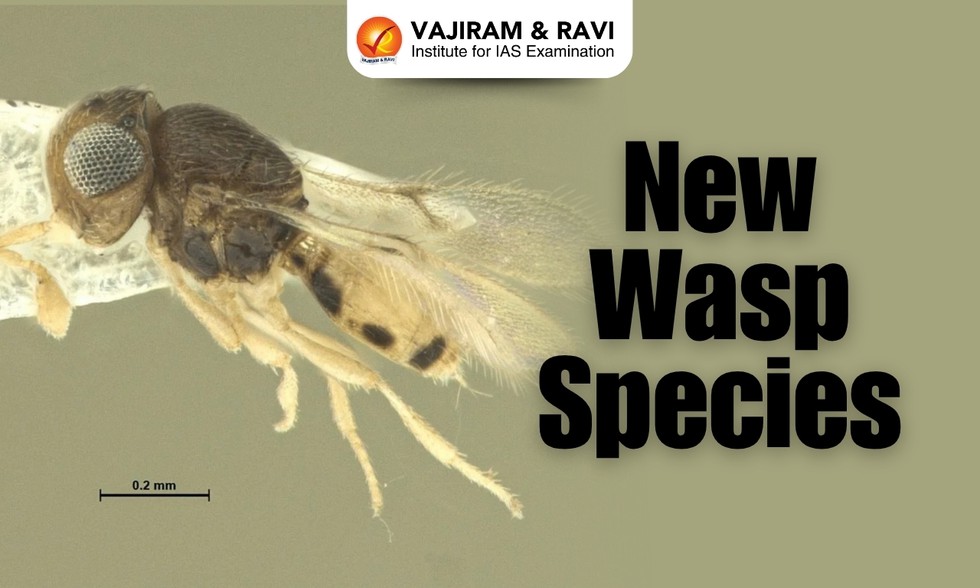
About New Wasp Species:
- The new species of parasitoid wasps belonging to the genus Idris(Hymenoptera: Scelionidae).
- These tiny wasps — Idris bianor, Idris furvus, Idris hyllus, and Idris longiscapus— were collected from agroecosystems and semi-natural habitats across West Bengal.
- Features New Wasps
- These extremely small microscopic wasps belong to the genus Idris Förster and are known for laying their eggs inside spider egg sacs.
- These are primary egg parasitoids of jumping spiders (Salticidae).
- They exhibit an interesting behaviour pattern, the scientists noted that instead of just one wasp growing inside each spider egg sac, many baby wasps grow together and are called “gregarious parasitism”.
- Significance of wasps: Parasitoid wasps like Idris play a key role in regulating spider populations and maintaining arthropod community balance.
Key facts about Parasitism
- It is a relationship between two species of plants or animals in which one benefits at the expense of the other, sometimes without killing the host organism.
- In parasitism only one species benefits (parasite and predator, respectively) and the interaction is detrimental to the other species (host and prey, respectively).
- Predation, parasitism and commensalism share a common characteristic– the interacting species live closely together.
- Brood parasitism in birds is a fascinating example of parasitism in which the parasitic bird lays its eggs in the nest of its host and lets the host incubate them.
Prelims Pointers
July 28, 2025

About Exercise Bold Kurukshetra 2025:
- It is a joint military Exercise conducted between India and Singapore.
- It was first conducted in 2005, this exercise underscores the strong and long-standing bilateral defence relationship between both countries and enhances cooperation between the two armies.
- The exercise will witness the participation of the 42 Singapore Armoured Regiment of the 4 Singapore Armoured Brigade and the Indian Army’s Mechanised Infantry Regiment.
- The exercise will be conducted as a Table Top Exercise and Computer-Based Wargame, aimed at validating operational procedures for mechanised warfare.
- Objective: The objective of the exercise is to enhance interoperability and joint training capabilities of both armies under United Nations mandate, thereby strengthening bilateral defence cooperation.
- Both defence establishments also interact regularly through high-level visits, policy dialogues, courses and other professional exchanges.
- Significance: Exercise Bold Kurukshetra 2025 will further consolidate the strong defence ties between India and Singapore and foster greater mutual understanding and collaboration at both tactical and strategic levels.

